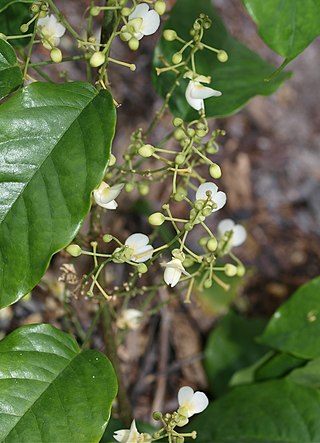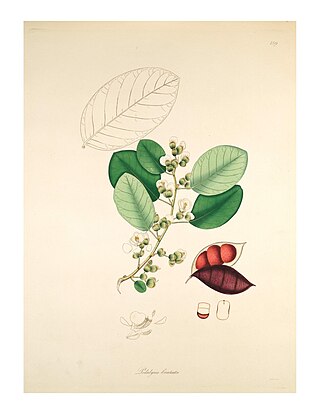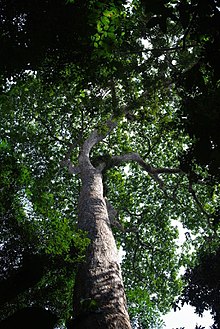
Camoensia is a genus of 2 species of lianas in the family Fabaceae, subfamily Faboideae, native to the Gulf of Guinea, Africa. C. scandens is cultivated as an ornamental plant; it has one of the largest leguminous flowers, up to 20 cm across. The genus has classically been assigned to the tribe Sophoreae, but was recently assigned to its own monophyletic tribe, Camoensieae, on the basis of molecular phylogenetic evidence. Species of Camoensia are known to produce quinolizidine alkaloids, consistent with their placement in the genistoid clade.

Baphia is a small genus of legumes that bear simple leaves. Baphia is from the Greek word βάπτω, referring to a red dye that is extracted from the heartwood of tropical species. The genus is restricted to the African tropics. Baphia was traditionally assigned to the tribe Sophoreae; however, recent molecular phylogenetic analyses reassigned Baphia to the tribe Baphieae.

Airyantha is a small genus of flowering plants in the legume family, Fabaceae. It belongs to the subfamily Faboideae. It was named after the botanist Herbert Kenneth Airy Shaw. It was traditionally assigned to the tribe Sophoreae; however, recent molecular phylogenetic analyses reassigned Airyantha into the Baphieae tribe.
Baphiopsis parviflora is an African species of flowering plants in the legume family, Fabaceae. It is the sole species in genus Baphiopsis. It is a shrub or tree which ranges from Cameroon to Tanzania and Angola.

Dalhousiea is a genus of flowering plants in the legume family, Fabaceae. It belongs to the subfamily Faboideae. It includes two species, one native to central Africa, and the other to eastern India, Bangladesh, and Myanmar.

Hypocalyptus is a genus of flowering plants in the family Fabaceae. It includes three species of shrubs, subshrubs or small trees native to the Cape region of South Africa. Typical habitats include Mediterranean-climate shrubland (fynbos) at forest margins, in rocky and sandy areas, and along streams, often at high elevations.
Leucomphalos is a genus of flowering plants in the legume family, Fabaceae. It contains a single species, Leucomphalos capparideus, a climbing perennial shrub native to the Guineo-Congolian forest of Nigeria, Cameroon, Equatorial Guinea, Gabon, and the Gulf of Guinea Islands. It belongs to the subfamily Faboideae. Leucomphalos was traditionally assigned to the tribe Sophoreae; however, recent molecular phylogenetic analyses reassigned Leucomphalos to the Baphieae tribe.

Luetzelburgia is a genus of flowering plants in the legume family, Fabaceae. It includes 14 species of trees and shrubs native to Brazil, Bolivia, and Colombia. Typical habitat is seasonally-dry tropical lowland woodland and wooded grassland, and occasionally lowland rain forests. The genus belongs to the subfamily Faboideae. It was traditionally assigned to the tribe Sophoreae, mainly on the basis of flower morphology; recent molecular phylogenetic analyses assigned Luetzelburgia into an informal, monophyletic clade called the "vataireoids". Keys for the different species of Luetzelburgia have been published.
Sweetia fruticosa is a species of flowering plants in the legume family, Fabaceae. It is a tree native to eastern, southern, and west-central Brazil, Bolivia, Paraguay, and northeastern Argentina. It is the only member of the genus Sweetia. It belongs to the subfamily Faboideae. It was traditionally assigned to the tribe Sophoreae, mainly on the basis of flower morphology; recent molecular phylogenetic analyses assigned Sweetia fruticosa into an informal, monophyletic clade called the "vataireoids".

Vatairea is a genus of flowering plants in the legume family, Fabaceae. It includes eight species of tall trees native to the tropical Americas, ranging from southern Mexico to Bolivia and southern Brazil. Seven species are native to northern South America, with the center of diversity in Amazonia. Vatairea lundellii ranges from southern Mexico to Panama. Most species grow in tropical rain forest, often in the inundated forests known as igapó and varzea, where they are emergent trees, growing above the forest canopy. V. macrocarpa grows in seasonally-dry forest, cerrado, and caatinga.
Vataireopsis is a genus of flowering plants in the legume family, Fabaceae. It includes four species of small to emergent trees, native to northern South America, ranging from Colombia, Venezuela, and the Guianas to Bolivia and southern Brazil. They grow in tropical lowland rain forest, in both the Amazon and Atlantic Forest.

The tribe Dipterygeae is one of the subdivisions of the plant family Fabaceae. It was recently recircumscribed to include the following genera:

The tribe Sophoreae is one of the subdivisions of the plant family Fabaceae. Traditionally this tribe has been used as a wastebasket taxon to accommodate genera of Faboideae which exhibit actinomorphic, rather than zygomorphic floral symmetry and/or incompletely differentiated petals and free stamens. Various morphological and molecular analyses indicated that Sophoreae as traditionally circumscribed was polyphyletic. This led to a re-circumscription of Sophoreae, which resulted in the transfer of many genera to other tribes. This also necessitated the inclusion of two former tribes, Euchresteae and Thermopsideae, in the new definition of Sophoreae. Tribe Sophoreae, as currently circumscribed, consistently forms a monophyletic clade in molecular phylogenetic analyses. The Sophoreae arose 40.8 ± 2.4 million years ago.

The vataireoids are an early-branching monophyletic clade of the flowering plant subfamily Faboideae that are mostly found in northern South America, primarily Brazil.

The non-protein amino acid-accumulating clade, also known as the Canavanine-accumulating clade is a clade of the flowering plant subfamily Faboideae that includes the majority of agriculturally-cultivated legumes. It is characterized by the accumulation of the non-proteinogenic amino acid canavanine in the seeds—a deterrent against herbivory. This phylogenetic trait was first recognized in the early 1980s. This clade is consistently resolved in molecular phylogenies. It contains many economically important genera, including Cicer, Glycine, Medicago, Phaseolus, Trifolium, Vicia, and Vigna.
The Andira clade is a predominantly Neotropical, monophyletic clade of the flowering plant subfamily Faboideae. The members of this clade were formerly included in tribe Dalbergieae, but this placement was questioned due to differences in wood anatomy and fruit, seed, seedling, floral, and vegetative characters. Recent molecular phylogenetic evidence has shown that they belong to a unique evolutionary lineage. It is predicted to have diverged from the other legume lineages in the late Eocene).
The tribe Ormosieae is one of the subdivisions of the plant family Fabaceae, primarily found in tropical regions of the Americas, but also in southeast Asia and northern Australia. The members of this tribe were formerly included in tribe Sophoreae, but were recently circumscribed into a new tribe. The members of this tribe consistently form a monophyletic clade in molecular phylogenetic analyses. The tribe does not currently have a node-based definition, but morphological synapomorphies have been tentatively identified: "mostly dehiscent pods with woody valves" and "tufts of minute colleter-like glands in the axils of bract and bracteoles". Like other genistoids, members of tribe Ormosieae are known to produce quinolizidine alkaloids.

The tribe Baphieae is one of the subdivisions of the plant family Fabaceae. The Baphieae tribe arose 55.3 ± 0.4 million years ago.
Baphiastrum is a genus of flowering plants in the legume family (Fabaceae). It includes a single species, Baphiastrum brachycarpum, a liana native to west-central Africa. It grows in Guineo-Congolian forest in Cameroon, Gabon, Republic of the Congo, Central African Republic, and Democratic Republic of the Congo.
Bowringia is a genus of flowering plants in the legume family (Fabaceae), found in tropical Africa and southeastern Asia. It includes four species native to western and central Africa and Madagascar, and to Borneo, Indochina, and southern China.










